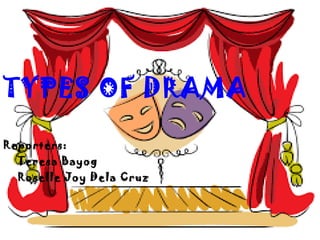
Types of Drama Explained
- 1. TYPES OF DRAMA Reporters: Teresa Bayog Roselle Joy Dela Cruz
- 2. I. TRAGEDY -exposes the plight and sufferings of humans to the audience -comes from the Greek word tragoida which means “goat song” . -the three great playwrights of tragedy were Aeschylus, Sophocles and Euripides
- 3. KINDS OF TRAGEDY TRADITIONAL TRAGEDY -featuring noble characters in an irretrievable situation that elicits their immense capacity for suffering and promise for a better tomorrow, the vision of the play is dark. Example: Romeo and Juliet by William Shakespeare
- 4. MODERN TRAGEDY -characters rise to the status of exceptional characters facing a tragic web of circumstances and personal weaknesses that spell their doom in an unsympathetic world. Example: A Streetcar Named Desire by Tennessee Williams DOMESTIC TRAGEDY -a tragedy in which the tragic protagonists are ordinary middle class individuals. Example: Doll's House by Henrik Ibsen
- 5. TRAGICOMEDY -a mixture of tragic and comic elements existing in a single dramatic work. Example: Waiting for Godot by Samuel Beckett REVENGE TRAGEDY -dramatic works in which one character seeks revenge upon another character from an evil doing. Example: Hamlet by William Shakespeare
- 6. II. SATYR PLAYS -short plays performed between the acts of tragedies and made fun of the plight of the tragedies characters. Satyr- a mythical half-human, half-goat figures, and actors in the play who wore large phalluses for comic effect.
- 7. III. MELODRAMA -emphasizes action and spectacular effects. -historically employed stock characters engaged in an ambiguous struggle between good and evil with music under the action scenes.
- 8. IV. COMEDY -a humorous play in which the actors dominate the action. -intends to make the audience laugh.
- 9. Kinds of Comedy Romantic Comedy -a composite genre which centers mostly on the vicissitudes of young lovers who get happily united in the end. Comedy of Humors -based on the medieval and Renaissance beliefs that people's actions are governed by their dominant bodily humors.
- 10. Satirical Comedy -main purpose is to expose the vices and shortcomings of society and of people representing that society. Comedy of Manners -depicts a stylish society, mainly the middle and upper classes, its focus is on elegance, with characters of fashion and rank.
- 11. Sentimental Comedy -focuses on the virtues of private life, with simple and honorable characters. Farce -intends to provoke simple mirth in the form of roars of laughter. -aims at entertaining the audience through situations that are highly exaggerated, extravagant, and thus improbable.
- 12. Black Comedy -displays cynicism and disillusionment, human beings without hope or convictions, their lives controlled by fate or unknown and incomprehensible powers.
